It’s official. After months of speculation, Google’s AI Search Guidelines have dropped, and they’re a game-changer.
Google has finally given SEOs and content strategists clear advice on how to succeed in its AI-powered search results.
Let’s break down Google search updates 2025 and explore what it really takes to stay visible when AI answers come first.
How does your website score? Get a free instant audit that will uncover the biggest SEO issues affecting your site, and how to fix them.
Article Summary
- Google confirms that content must be original, useful, and written for people, not just algorithms
- E-E-A-T remains essential, especially experience-led content that shows firsthand knowledge
- AI-generated content is allowed, but human oversight and authenticity are required
- SEO is shifting from keywords to real-world relevance and intent-based answers
- Trust signals like author bios, citations, and structured data help content get cited in AI Overviews
- Schema markup for authors, organizations, and FAQs improves visibility in AI results
- To stay competitive, brands must publish unique insights, monitor AI Overview appearances, and diversify content formats
- SEO isn’t dead, it’s evolving into AI visibility, and the winners will optimize across search, apps, chat, and voice
What Did Google Actually Say?
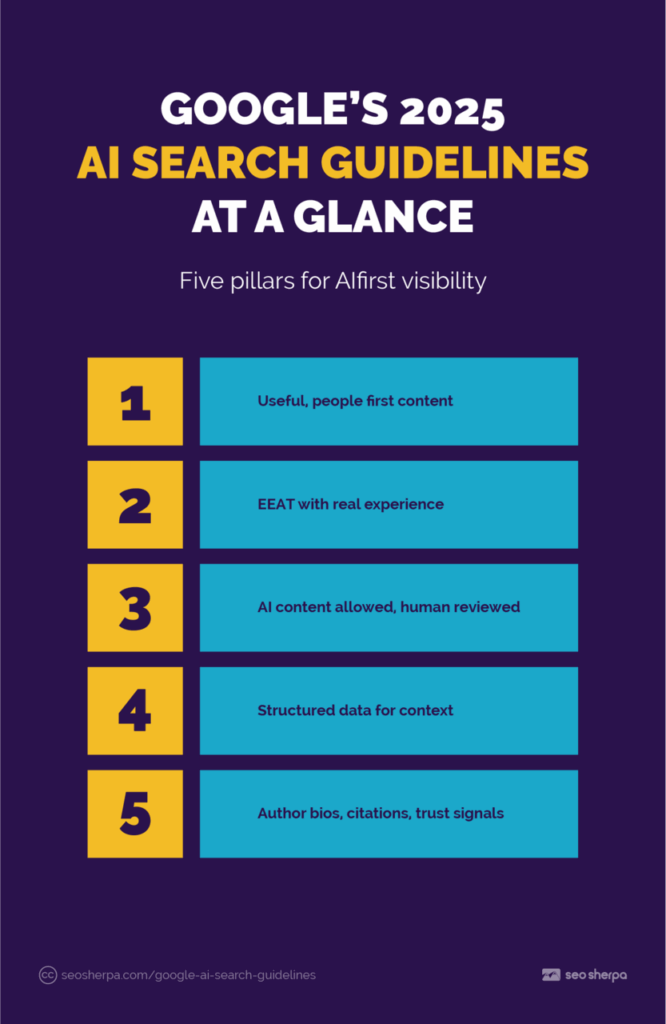
In a blog post that many of us had bookmarked in hope, Search Advocate, John Mueller, finally addressed the elephant in the room: “What are Google’s new AI search guidelines?” His answer was equal parts comforting and revealing.
Google’s core message?
The fundamentals still matter, “Focus on your visitors and provide them with unique, satisfying content.”
People-first content remains the goal.
But it’s not just about writing for humans.
The advice zeroes in on quality and originality.
Google wants “unique, non-commodity content” designed to help people, not manipulate algorithms.
Mueller reiterates that the same pillars still drive performance: usefulness, originality, and relevance.
Whether your content is human-written or AI-content, those are still the signals that count.
E-E-A-T is also alive and well.
Google reminds us that experience, expertise, authoritativeness, and trustworthiness apply to everything, including AI-generated material.
In short, if your content is useful, original, and shows expertise, you’re in the game. If it’s lazy or thin, expect it to be ignored.
Google didn’t dance around the role of AI, either.
The guidelines make it clear: AI is a tool, not a replacement.
Think of AI as your assistant. Great for drafting and structuring, but not the final word. People-first content rich in E-E-A-T is still the end goal.
The Big Shift: From Keywords to Real-World Experience
Beyond the specific guidance, Google’s update signals a much bigger shift: SEO is moving away from keyword obsession and toward real-world context and experience.
Thanks to models like BERT and MUM, Google now understands language at a deeper, more human level.
Users aren’t just typing keywords, they’re having conversations with the search engine.
In fact, Google says there’s been a “profound shift” in behavior. People are asking longer, more complex questions, often in follow-up form.
Instead of typing for example “E-E-A-T Google AI,” users now ask things like “How do AI Overviews impact SEO?” or “Is EEAT still relevant in the age of generative search?”
They want detailed, direct answers, not blog posts padded with fluff.
That’s why AI-powered search (through Google’s AI Overviews and the new AI Mode) is built to synthesize answers, not just match terms.
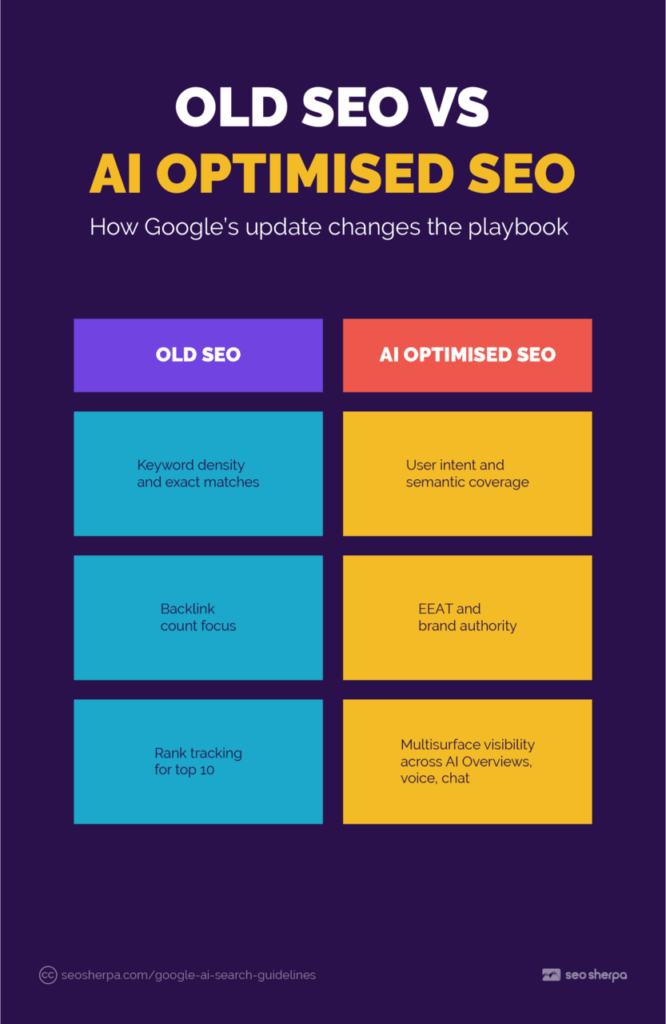
The AI cares more about topic depth and true expertise.
If your content fully answers a niche or specific question, especially with authority, you’re more likely to win visibility. But thin, generic keyword-laced content won’t even get a second look.
As Google puts it, “thorough, detailed content” performs well in AI because users are asking very specific things.
Specificity is also now a ranking factor.
And that brings us to one of the biggest takeaways: firsthand experience matters more than ever.
Google’s algorithms and its Helpful Content system now look for signals that the creator has actually lived the topic.
If someone’s writing about a product, can you tell they’ve used it?
If they’re giving health advice, do they have medical expertise?
That’s what the extra “E” in E-E-A-T stands for: experience.
And it’s no accident.
Content that shows real-world knowledge outranks summaries scraped from elsewhere.
A travel guide written by someone who’s been there beats an AI-generated “top 10” list every time.
Google’s systems increasingly connect content to known entities, people, brands, experts, to establish credibility.
That’s where structured data like Person schema comes in (more on that shortly). If your author is a known expert, the AI will factor that in.
Key Implications for SEOs and Brands
For practitioners, these new guidelines translate into some clear strategy shifts. Credibility now outweighs keyword density.
Google’s AI-powered results prioritise content from sources it trusts, and that trust isn’t built through keyword stuffing.
It’s built through author pages, source transparency, and strong external signals.
In an AI Overview, Google might pull from two or three sources to form an answer. You want to be one of them.
You might be asking, “How do I optimize for Google’s AI Overviews in 2025?”
Start by building trust signals around every piece of content.
Make sure every article has a clear author, ideally with proven expertise. Link their name to a detailed bio or LinkedIn profile.

Then, reinforce your site’s reputation. Backlinks from credible domains, press mentions, and high-quality citations all help.
Even third-party reviews and references can tip the trust scales in your favor.
These are the breadcrumbs Google’s AI follows to gauge authority.
If you’re consistently cited by other trusted entities, your content is more likely to make the AI’s shortlist.
On the flip side, content with no authorship, no citations, and a weak backlink profile? It might get ignored, even if it technically has the right keywords.
This isn’t speculation either. Google’s own docs tell publishers to “focus on people-first content” and pay attention to author information and sourcing.
We’re optimizing for two audiences now: human readers and Google’s AI. And both demand authenticity.
Another big takeaway?
Structured data is no longer optional.
Structured data gives Google’s models explicit context about your content. It connects the dots between your site and what the AI thinks it’s seeing .
And it’s not just for nerds.
Adding the right schema types can make a real difference in how your content is interpreted and surfaced.
Start with the basics: Organization schema to define your brand, Person schema for authors, and WebPage or FAQPage schema to label your content’s role.
For example, if Jane Doe writes your health article, mark her up with Person schema and link it to her medical credentials. That way, Google knows she’s the same Dr. Jane Doe listed on a university site.
FAQ schema also plays a role. Add it to troubleshooting content or support pages, those often get picked up in AI answers.
And it’s not just for the AI layer. Schema can trigger rich results, which often appear alongside or within AI summaries, boosting your visibility from multiple angles.
Google’s own AI documentation now lists structured data as a best practice, with one condition: make sure the schema matches your visible content.
In short, schema helps the AI trust you faster. If it can easily verify your About page, parse your FAQ answers, and match your author with known credentials, you’ve checked multiple E-E-A-T boxes in one go.
And if you’re operating in YMYL territory, health, finance, legal, or anything high-stakes, this trust layer is mission-critical.
That means including visible credentials, external citations, expert reviewers, and disclaimers where needed.
So, highlight that authority. If Dr. Smith has 20 years of experience in cardiology, say it, on your About page, your articles, and your schema.
Link to reputable sources, keep trust signals updated, and make sure your site reflects current best practices around data security and transparency.
Is your brand ready for AI Overviews?
Book a free discovery call with our SEO experts and get tailored advice on optimizing your site for Google’s new search experience.
What to Do Now – Your AI Search Optimization Checklist
So, how do you put all of this into practice?
Here’s your five-part AI search checklist, each step with clear, immediate actions.
Audit and surface experience-led content across your site
Start by identifying pages that show real expertise. Did your engineer publish a hands-on case study? Is there customer research or a field-tested guide hiding in your blog archive?
Find them, polish them, and bring them forward. Content that highlights firsthand experience signals to Google’s AI that your site has the depth that others don’t.
Improve schema markup, especially for authors, your org, and topic hubs
Your structured data is the shortcut for AI understanding. Make sure your Organization schema links to your brand’s logo, social profiles, and official name.
Add Article schema with clear author and publisher info. Mark up each author page with Person schema, include credentials, awards, and sameAs links to LinkedIn or other sources.
If you’ve got distinct content clusters, define those with WebPage schema (e.g. for About, FAQ, or Category pages). And yes, add FAQPage schema where it fits.
Prioritize original reporting, insights, and un-Googleable knowledge
Content planning needs a shift: stop rehashing what’s already out there. Instead, create what only you can, whether that’s internal data, expert interviews, or lived experience.
A generic “10 tips” blog won’t stand out. But a teardown of how your team solved a problem in the wild? That’s gold.
Google’s AI craves original thinking. If your content offers the first or only mention of something valuable, it’s far more likely to be surfaced, cited, and linked.
Make it a KPI: every page should include at least one insight users (and AI) won’t find anywhere else.
Monitor when your content appears in AI Overviews
This is a new kind of SERP visibility, and a new metric to track. Google Search Console now reports AI Overview impressions and clicks under the “Web” search type.
Watch those queries. If a page shows up frequently in AI answers, that’s a sign of trust, even if click-throughs are modest.
If you’re not showing up where competitors are, study their content. Is it deeper? More focused? Do they have better schema or clearer sourcing?
Treat AI Overview mentions like a featured snippet, they’re the new top-of-page real estate.
Diversify content formats to expand your semantic footprint
Google’s AI isn’t just reading your blog, it’s scanning your site holistically. If your entire content strategy is short blog posts, you’re missing out.
Add long-form guides to cover complex queries. Build out FAQs and Q&A pages for high-intent searches. Create short videos, visuals, or explainers that feed into Google’s multimodal model.
User reviews and testimonials also count, they add real-world trust and context. Plus, with review schema, they can be pulled into product-related AI answers.
The more formats you publish, the more entry points you create for AI to recognize and reuse your content.
Want to double-check your site’s readiness for AI-driven search?
Grab our free Technical SEO Checklist, it covers everything from schema to site speed to help you meet Google’s latest visibility standards.
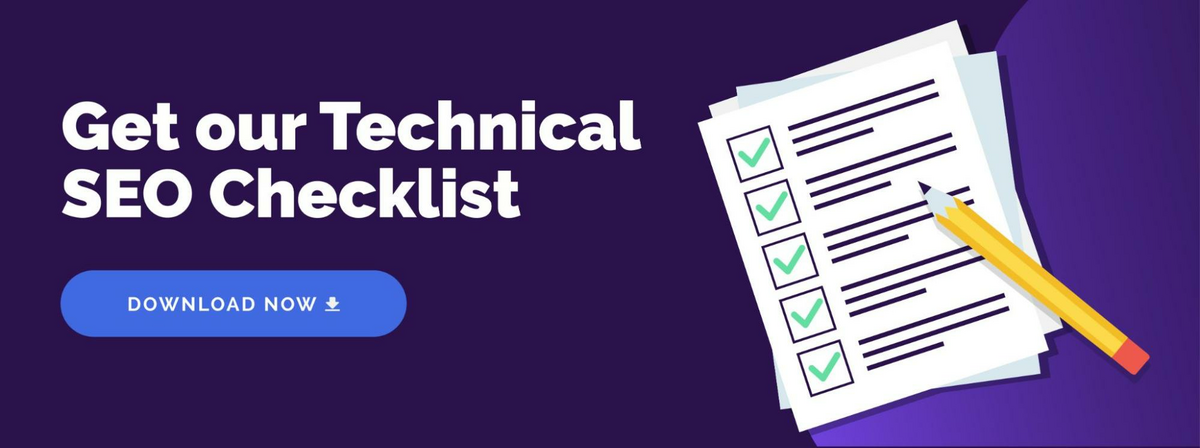
Is This the End of Traditional SEO?
Let’s tackle the obvious question: with all these AI changes, is SEO dead?
Short answer: No!
But traditional keyword SEO is no longer the lead actor.
Ranking #1 doesn’t guarantee traffic when AI answers show up above the fold.
Google’s Search Generative Experience (SGE) is changing how people use search. And the early numbers are brutal.
When AI Overviews appear, organic clicks drop hard. Some reports show CTR declines of up to 70% when AI summaries are present.
Even when AI isn’t in play, featured snippets and instant answers are eating into clicks. By 2024, nearly 60% of Google searches ended with zero clicks. SGE is only accelerating that trend.
So, yes. SEO as a game of “rank and collect clicks” is fading. But SEO itself isn’t dying. It’s evolving into something bigger.
The new goal isn’t just ranking. It’s visibility, relevance, and being cited in the answers users already trust.
You still need to optimize. But not just for the SERP, now it’s for AI Overview SEO, voice search, rich results, SEO for SGE (Search Generative Experience), and everywhere else search spills over.
Keywords still matter. But they’re just one input in a much more complex system.
Embrace the Shift or Get Left Behind
Here’s the reality: AI is no longer just powering search behind the scenes. It is the interface.
Search is turning into a conversation between users and AI. And your content? It gets included only if the AI trusts it enough to cite.
That means visibility isn’t just about search rankings anymore. It’s about being discoverable across multiple surfaces and formats.
Sometimes that’s a citation in an AI Overview. Sometimes it’s a snippet on Google, a result in Bing’s chatbot, or a video pulled into a carousel.
Search is now happening everywhere. If you’re still thinking in terms of blue links and positions, you’re playing last year’s game.
So, stop obsessing over keyword rankings. Yes, they matter, but not as much as total discoverability.
Ask yourself: can someone find your brand even if they don’t search for it by name? If they ask their smart assistant a question in your niche, does your content make the cut?
If not, you’ve got work to do. But it’s the kind of work that pays off in every future version of search.
The brands that win are already shifting gears. They’re embracing what we call Search Everywhere Optimization.
That means thinking beyond Google’s index. It means optimizing for AI systems, app search, social platforms, chatbots, and everywhere else discovery happens.
Ready to future-proof your visibility beyond blue links?
Download our free Search Everywhere Optimization ebook and get a playbook for dominating AI-powered, cross-platform discovery.

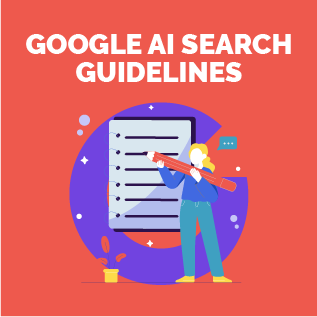

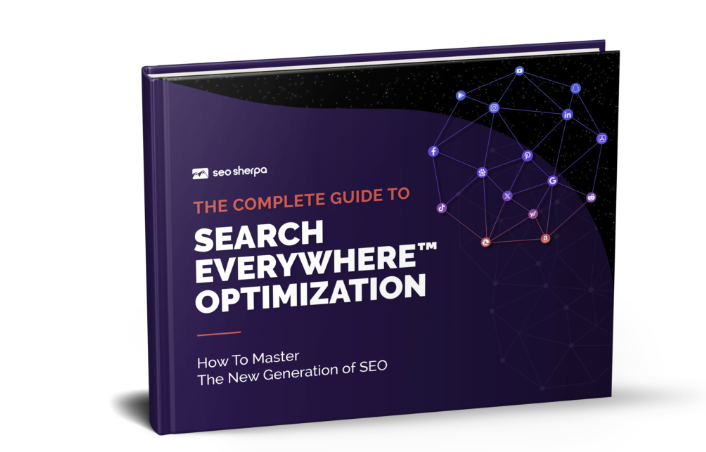


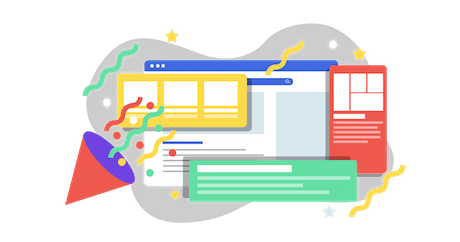
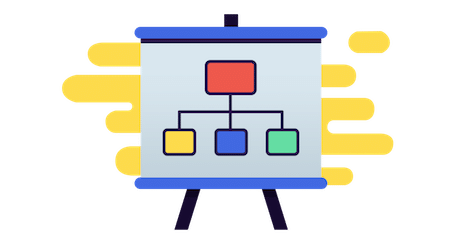
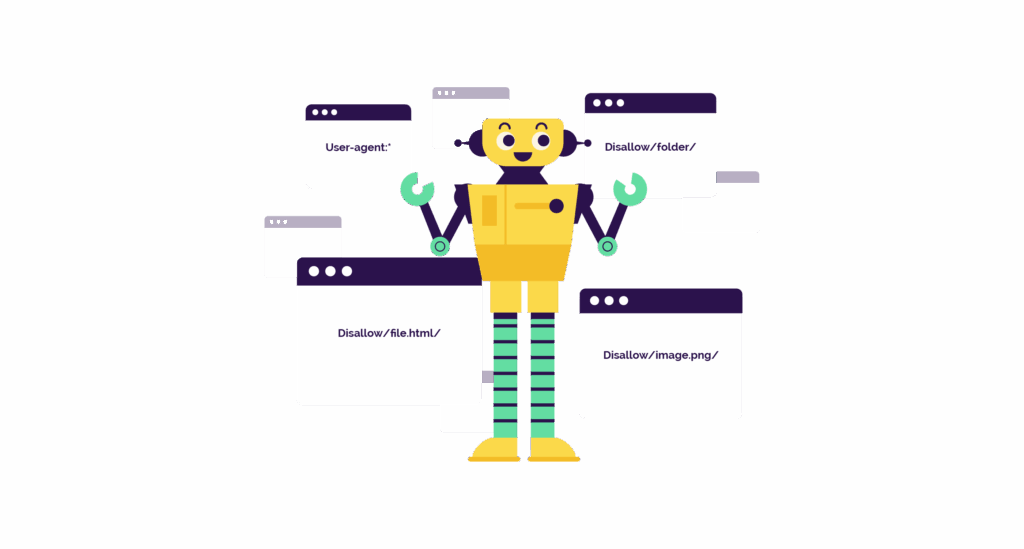

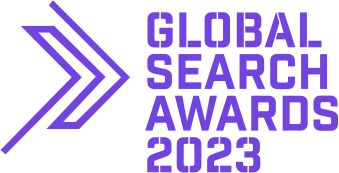


Leave a Reply